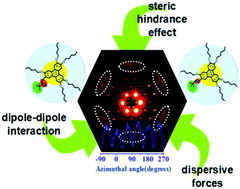The leading role of the steric hindrance effect and dipole–dipole interaction in superlattice nanostructures formed via the assembly of discotic liquid crystals†
Abstract
To reveal the relationships among molecular structures, self-assembly behavior and the organic electronic properties of discotic liquid crystals, 2-(neopentyloxy)-3,6,7,10,11-pentakis(pentyloxy)triphenylene (T5ON1) and 2-pivalate-3,6,7,10,11-penta-pentyloxy-triphenylene (T5EP1) have been synthesized based on hexapentyloxy-triphenylene (HAT5). Their mesomorphic properties were studied by differential scanning calorimetry (DSC), one-dimensional wide-angle X-ray diffraction (1D WAXD) and two-dimensional wide-angle X-ray diffraction (2D WAXD). T5ON1 and T5EP1 showed an ordered hexagonal columnar phase and a highly ordered hexagonal columnar plastic phase, respectively. To our surprise, Transmission Electron Microscope (TEM) images proved that a uniformly distributed superlattice nanostructure formed in the organic system of T5EP1. In addition, the hole and electron mobilities of T5EP1, which were 3.66 × 10−2 cm2 V−1 s−1 and 3.33 × 10−2 cm2 V−1 s−1, respectively, indicated that T5EP1 was a bipolar charge carrier transport material.



 Please wait while we load your content...
Please wait while we load your content...